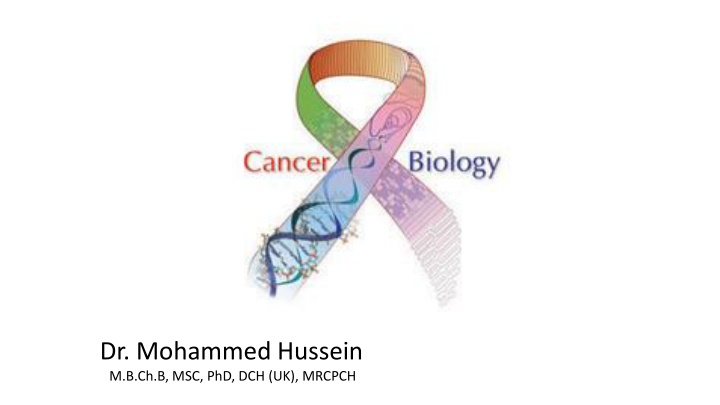
Cancer Biology: Insights into Oncogenes and Tumor Suppressor Genes
Explore the fundamentals of cancer biology, distinguishing between tumors and cancer, and delving into the role of oncogenes and tumor suppressor genes in the development of cancer. Discover the significance of proto-oncogenes and their potential transformation into oncogenes, shedding light on the intricate mechanisms governing unregulated cell growth in cancer progression.
Download Presentation

Please find below an Image/Link to download the presentation.
The content on the website is provided AS IS for your information and personal use only. It may not be sold, licensed, or shared on other websites without obtaining consent from the author. If you encounter any issues during the download, it is possible that the publisher has removed the file from their server.
You are allowed to download the files provided on this website for personal or commercial use, subject to the condition that they are used lawfully. All files are the property of their respective owners.
The content on the website is provided AS IS for your information and personal use only. It may not be sold, licensed, or shared on other websites without obtaining consent from the author.
E N D
Presentation Transcript
Dr. Mohammed Hussein M.B.Ch.B, MSC, PhD, DCH (UK), MRCPCH
Tumor can be benign, pre-malignant, or malignant, whereas cancer is by definition malignant.
Cancer is a group of diseases characterized by unregulated cell growth and the invasion and spread of cells from the site of origin, or primary site, to other sites in the body.
Cancer Biology Oncogenes Tumor suppressor gene Apoptosis Onco = Greek word tumor Apoptosis = Greek word falling off
Cancer Oncogene Tumor suppressor gene Normal Cell Oncogene Tumor suppressor gene No Cancer
Oncogene Tumor suppressor geneCancer Apoptosis
Oncogene An oncogene is a gene that has the potential to cause cancer
Proto-oncogene Proto-oncogenes are the normal genes involved in the regulation of controlled cell growth. When the proto-oncogene is mutated or overregulated, it is called an oncogeneand results in unregulated cell growth and transformation
1 2 3 4
Proto-oncogenes These genes encode proteins that function as 1. Growth factors 2. Growth factor receptors 3. Signal transducing proteins 4. Nuclear transcription factors
Growth Factors Aberrant production of these proteins can result in aberrant transition from G0 to G1, with subsequent uncontrolled growth.
Growth Factors Fibroblast growth factors (FGFs) are a family of proteins that are normally expressed during the proliferation of cells required for normal wound healing, but overexpression can lead to tumor formation. Platelet-derived growth factor (PDGF) is a polypeptide that is normally important for extracellular matrix production, but overexpression may result in proliferation as a result of autocrine stimulation.
Structure of the cell surface receptors Extracellular Domain Transmembrane Domain Intracellular Domain
Intracellular domain The intracellular (or cytoplasmic) domain of the receptor interacts with the interior of the cell or organelle, relaying the signal. Often, this is tyrosine kinase activity.
Growth Factor Receptors 1. Epidermal growth factor receptors (EGFRs) 2. Rearranged during transfection (RET)
Overexpression of the growth factor receptor known as HER2/neu, is associated with the development of breast cancers.
Mutations in RET are commonly associated with multiple endocrine neoplasia (MEN) syndromes, including MEN I, and MEN II.
The next level at which defects in cell growth and development can occur is at the level of downstream signal transduction proteins. Two such examples are given: 1. The ras gene 2. Nonreceptor tyrosine kinase proteins
The ras gene is the most commonly mutated oncogene in cancer, with 10% to 20% of tumors harboring mutations in ras. Mutations in ras are found in a large number of tumors of the colon, pancreas, and thyroid.
Nuclear transcription proteins These transcription proteins, such as the proto-oncogene myc, integrate divergent growth-promoting pathways and ultimately lead to the production of proteins that allow the cell to advance through the cell cycle.
The nuclear transcription protein WT-1, coded for on chromosome 11, is mutated in Wilms tumors (the most common tumor of kidney in children)
Tumor suppressor genes Tumor circumstances, suppress cell growth. When their activity is reduced, result in uncontrolled cell growth suppressor genes are genes, under normal
Surface receptor Signal transduction Nuclear transcription
Cell surface molecules There are numerous cell surface molecules that antagonize normal cell growth and development 1. Transforming growth factor-b (TGF-b) receptor 2. The protein product of the DCC (deleted in colon carcinoma) gene
Molecules that regulate signal transduction These molecules possess an antagonistic role to the actions of intracellular proto-oncogenes. 1. NF-1 (Neurofibromatosis-1) geneproduct 2. The adenomatous polyposis coli (APC) gene product
Molecules that regulate nuclear transcription Several tumor-suppressor genes residing in the nucleus encode proteins that play an important role in the integration of growth- promoting and growth-inhibiting signals. 1. The retinoblastoma (Rb) gene is an important negative regulator of cell growth. 2. The p53 gene has an important gate-keeper role in cellular proliferation
Retinoblastoma (Rb) gene is an important negative regulator of cell growth Active Inactive No Cell Growth Cell Growth Rb gene CDK dependent phosphorylation p53 gene CDK inhibitor p21
p53 gene (the gate-keeper)
Retinoblastoma (Rb) gene is an important negative regulator of cell growth Active Inactive Cell Growth No Cell Growth Rb gene CDK dependent phosphorylation p53 gene CDK inhibitor p21
If DNA damage inflicted on the cell cannot be successfully repaired, p53 mediates the transcription of genes implicated in the process of programmed cell death, or apoptosis
Mutations in the tumor-suppressor gene, p53, are the most common molecular alterations in cancer, with more than 50% of human tumors harboring mutations in p53.
Apoptosis Is defined as the programmed destruction of the cell
Caspases Caspases normally exist in the cytoplasm as inactive zymogens until stimulated through any of the major pathways triggering apoptosis. Caspases degrade intracellular proteins and activate DNases, with resultant DNA fragmentation, or DNA laddering, which is characteristic of apoptosis.
Degradation of intracellular proteins Caspase Activate DNAases DNA fragmentation















